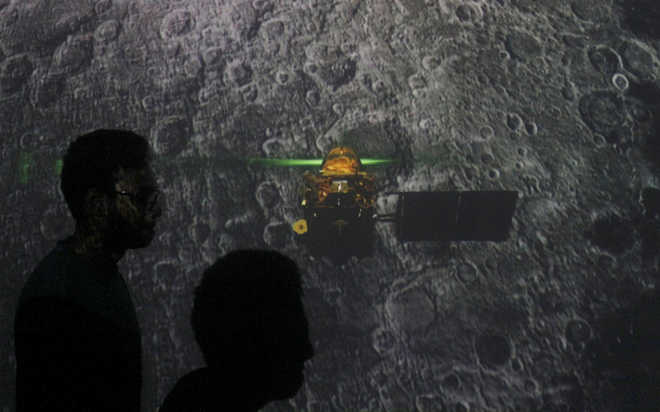Bengaluru, September 7
The Chandrayaan-2 orbiter is healthy and safe in the Lunar orbit, an ISRO official said after the Vikram lander lost contact with ground stations minutes before the touchdown on Moon’s surface early on Saturday.
“The orbiter is healthy, intact, functioning normally and safely in the Lunar orbit,” the official told PTI.
The mission life of the 2,379-kg orbiter is one year.
The orbiter payloads will conduct remote-sensing observations from a 100 km orbit.
Chandrayaan-2, a follow-on mission to the Chandrayaan-1 mission undertaken more than a decade ago, comprises an orbiter, lander (Vikram) and rover (Pragyan).
The orbiter carries eight scientific payloads for mapping the lunar surface and study the exosphere (outer atmosphere) of the Moon.
ISRO on September 2 successfully carried out the separation of lander Vikram (with rover Pragyan housed inside) from the Chandrayaan-2 orbiter.
In the early hours of Saturday, communication from ‘Vikram’ lander to ground stations was lost during its powered descent to the Lunar surface, and ISRO said data is being analysed.
“Vikram lander descent was as planned and normal performance was observed up to an altitude of 2.1 km.
Subsequently, the communication from lander to groundstations was lost,” ISRO Chairman K Sivan said.
Timeline of Chandrayaan-2
June 12: ISRO Chairman K Sivan announces India’s second sojourn to the moon, Chandrayaan-2, would be launched on July 15.
June 29: Rover after completion of all tests integrated with lander Vikram.
June 29: Vikram lander (assembled with Pragyan Rover) integrated with Orbiter.
July 4: Integration of encapsulated assembly of Chandrayaan-2 with launch vehicle (GSLV MkIII-M1) completed.
July 7: GSLV MkIII-M1 moved to launch pad.
July 14: Countdown for GSLV MkIII-M1/Chandrayaan-2 launch on July 15 commences.
July 15: ISRO calls off Chandrayaan-2 launch as a technical snag is observed in launch vehicle system about one hour before blast-off.
July 18: Chandrayaan-2 launch rescheduled for July 22, at 2.43 pm from second launch pad of SDSC, Sriharikota.
July 21: Countdown for GSLV MkIII-M1
/Chandrayaan-2 launch on July 22 commences.
July 22: GSLV MkIII-M1 successfully launches Chandrayaan-2 spacecraft.
July 24: First earth bound orbit raising manoeuvre for Chandrayaan-2 spacecraft was performed successfully.
July 26: Second earth bound manoeuvre performed.
July 29: Third earth bound manoeuvre performed.
August 2: Fourth earth bound manoeuvre performed.
August 4: ISRO releases first set of images of the earth captured by Chandrayaan-2 satellite.
August 6: Fifth earth bound manoeuvre performed.
August 14: Chandrayaan-2 successfully enters Lunar Transfer Trajectory.
August 20: Lunar Orbit Insertion. Chandrayaan-2 successfully inserted into Lunar orbit.
August 22: First set of pictures of Moon taken by Chandrayaan-2’s LI4 Camera from an altitude of about 2,650 km from the lunar surface released by ISRO.
August 21: Second lunar orbit manoeuvre performed.
August 26: ISRO releases second set of images of lunar surface captured by Terrain Mapping Camera-2 (TMC-2) of Chandrayaan 2.
August 28:Third lunar bound orbit manoeuvre performed.
August 30: Fourth lunar orbit manoeuvre performed.
September 1: Fifth and final lunar orbit manoeuvre performed.
September 2: Vikram lander successfully separates from Orbiter.
September 3: First de-orbiting manoeuvre performed to bring Vikram closer to moon.
September 4: Second de-orbiting manoeuvre performed.
September 7: Vikram lander begins its powered descent, normal performance was observed up to an altitude of 2.1 km, but loses contact with ground stations minutes before the crucial touchdown on the lunar surface. PTI
Unlock Exclusive Insights with The Tribune Premium
Take your experience further with Premium access.
Thought-provoking Opinions, Expert Analysis, In-depth Insights and other Member Only Benefits
Already a Member? Sign In Now










